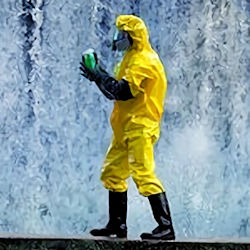Site Safety and Health Plan Components
33.B.02 The SSHP must cover the following in project-specific detail. General information adequately covered in the APP (introduction, site background, SOH organization and lines of authority, general site control and layout and general site safety procedures, logs, reports and inspections) need not be duplicated. Section 06.E Ionizing Radiation must be used to develop appropriate sections of the SSHP for HTRW projects involving radioactive isotopes.
- Site description and contamination characterization - a description of the contamination with the exposure potential to adversely affect safety and occupational health and likely to be encountered by the on-site work activities;
-
Activity Hazard Analysis (AHA). An AHA must be developed for each task/operation to be performed per Section 01.A.13.
The AHA must account for all hazards (classic safety, chemical, physical, biological, ionizing radiation) likely to be encountered while performing the work;
- Staff organization, qualifications, and responsibilities per Section 33.C;
- Training, general and project-specific per Section 33.D;
- Personal Protective Equipment (PPE). PPE used to protect workers from site- related hazards (construction safety and health and contaminant-related) must comply with requirements specified in Section 5;
- Medical surveillance. Certification of medical surveillance program participation must be appended to the SSHP and must include: employee name, date of last examination, and name of examining physician(s) and must be per Section 33.E. The required written physician's opinion must be made available upon request to the GDA;
-
Exposure monitoring/Air sampling program. Exposure monitoring and air sampling must be performed to determine if the PPE provides adequate protection and to evaluate worker exposure to site-related contaminants and hazardous substances used in the cleanup process. Project-specific exposure monitoring/air sampling requirements must comply with requirements specified Section 6;
- Heat and cold stress. The procedures and practices for protecting workers from heat and cold stress must comply with Section 06.J;
- Standard operating safety procedures (SOPs), engineering controls, and work practices. SOPs, engineering controls and work practices must be addressed for the following as appropriate:
- (1) Site rules/prohibitions (e.g., buddy system, eating/drinking/ smoking restrictions, etc.);
- (2) Work permit requirements (e.g., radioactive work, excavation, hot work, confined space, etc.);
- (3) Material handling procedures (e.g., soil, liquid, radioactive materials, spill contingency);
- (4) Drum/container/tank handling (e.g., opening, sampling, overpacking, draining, pumping, purging, inerting, cleaning, excavation and removal, disassembly and disposal, spill contingency);
- (5) Comprehensive AHA of treatment technologies employed at the site;
- Site control measures. Work zones must be established so that on-site activities do not spread contamination. The site must be set up so that there is a clearly defined exclusion zone (EZ) and a clearly defined support zone (SZ) with a contamination reduction zone (CRZ) as a transition between the EZ and SZ;
- Personal hygiene and decontamination. A personal hygiene and decontamination station must be set up in the CRZ for personnel to remove contaminated PPE and to wash when exiting the EZ;
- Equipment decontamination. An equipment decontamination station must be set up in the CRZ for equipment to be decontaminated when exiting the EZ;
-
Emergency equipment and first aid. The equipment and personnel required for first aid and CPR must comply with the requirements in Section 3.
Emergency equipment required to be on-site must have the capacity to respond to project-specific emergencies. Site emergencies may require (but should not be limited to) PPE and equipment to control fires, leaks and spills, or chemical (contaminant or treatment process) exposure;
- Emergency response and contingency procedures. Emergency Response Procedures must be developed that address the following:
- (1) Pre-emergency planning. An agreement must be established between the Contractor (or the GDA for in-house work), local emergency responders, and the servicing emergency medical facility that specifies the responsibilities of on-site personnel, emergency response personnel, and the emergency medical facility in the event of an on- site emergency;
- (2) Personnel and lines of authority for emergency situations;
- (3) Criteria and procedures for emergency recognition and site evacuation (e.g., emergency alarm systems, evacuation routes and reporting locations, site security);
- (4) Decontamination and medical treatment of injured personnel;
- (5) A route map to emergency medical facilities and phone numbers for emergency responders;
- (6) Criteria for alerting the local community responders.
Knowledge Check Choose the best answer for the question.
33-2. According to the HAZWOPER Safety and Health Plan (SSHP), what method is used to determine if the PPE provides adequate protection?
You forgot to answer the question!

